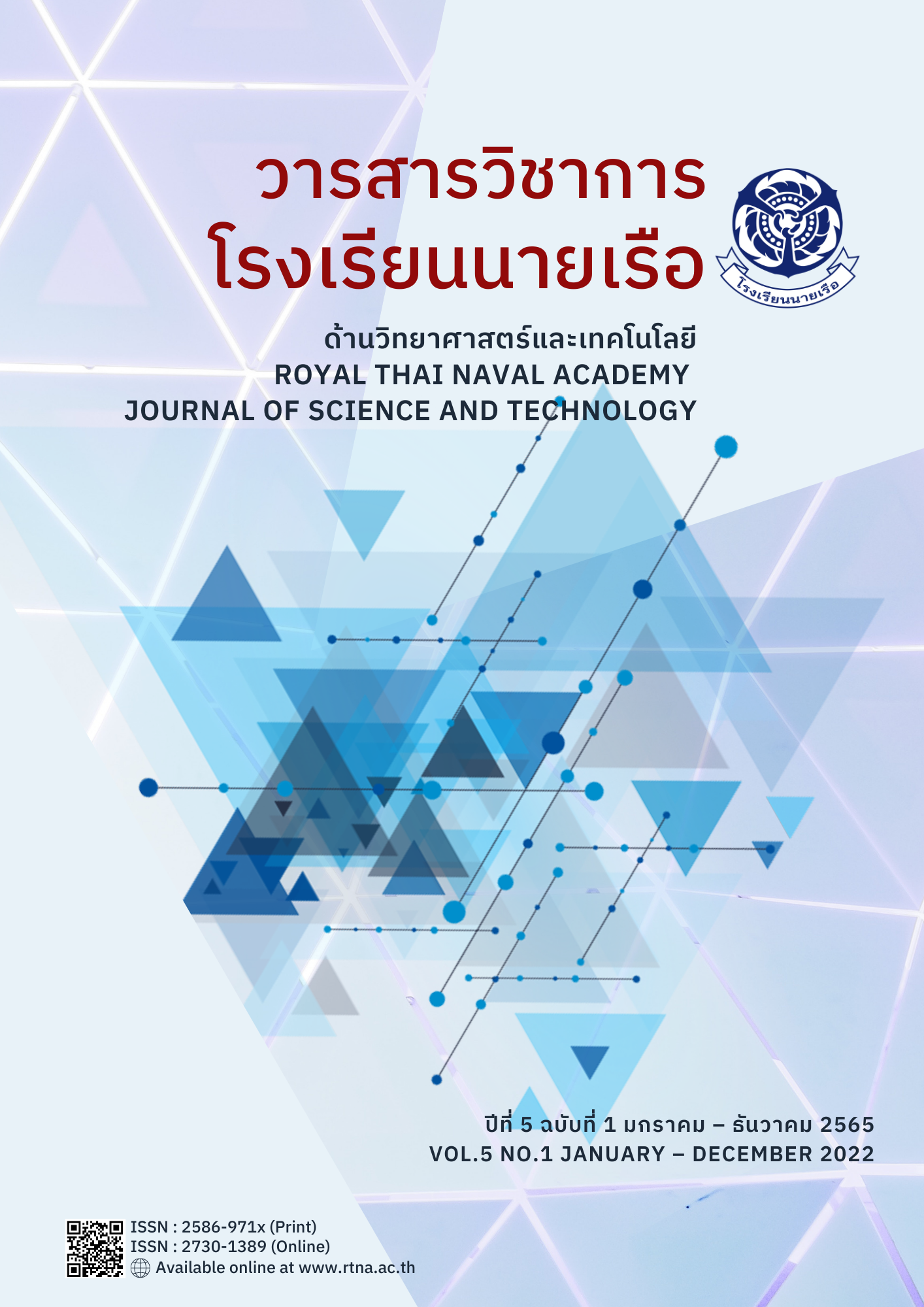การหยั่งความลึกน้ำทะเลจากการรับรู้ะยะไกลในอ่าวไทยด้วยภาพถ่ายดาวเทียมแลนด์แซท 8
Main Article Content
บทคัดย่อ
งานวิจัยนี้มีวัตถุประสงค์เพื่อประยุกต์ใช้ภาพถ่ายดาวเทียม Landsat 8 ทำการวิเคราะห์หาค่าความลึกน้ำทะเลในอ่าวไทย จำนวน 3 พื้นที่ อ้างอิงขอบเขตตามแผนที่เดินเรือ ได้แก่ พื้นที่อ่าวไทยรูปตัว ก (ทางเข้าแม่น้ำเจ้าพระยา) พื้นที่อ่าวไทยฝั่งตะวันออก (เกาะสะบ้า ถึง เกาะจิกนอก) และพื้นที่อ่าวไทยฝั่งตะวันตก(อ่าวชุมพร) ด้วยเทคนิคการสร้างแผนที่ความลึกน้ำทะเลด้วยวิธี Satellite Derived Bathymetry (SDB) ร่วมกับแบบจำลองอัตราส่วนช่วงคลื่น (Log - Band Ratio Method) เพื่อให้ได้ความลึกน้ำทะเลที่มีความแม่นยำสูงเมื่อเทียบกับฐานข้อมูลแผนที่เดินเรือจากการสำรวจด้วยวิธีการหยั่งน้ำด้วยเสียงแบบลำคลื่นเดียว ผลวิจัยพบว่าค่าความลึกน้ำทะเลจากวิธีการ SDB ช่วงความลึก 0 – 15 เมตร ในพื้นที่อ่าวไทยรูปตัว ก พื้นที่ อ่าวไทยฝั่งตะวันออก และพื้นที่อ่าวไทยฝั่งตะวันตก มีค่าสัมประสิทธิ์ตัวกำหนด (R2) เท่ากับ 0.8621, 0.9130 และ 0.9304 ตามลำดับ แสดงให้เห็นว่าความลึกน้ำทะเลจากวิธีการ SDB กับความลึกน้ำสำรวจมีความสอดคล้องกันสูง โดยเฉพาะพื้นที่อ่าวไทยฝั่งตะวันตก ดังนั้นวิธีการ SDB จึงสามารถใช้เป็นวิธีการทางเลือกในการสนับสนุนการสำรวจแผนที่อุทกศาสตร์ในพื้นที่ความลึกน้ำไม่เกิน 15 เมตร ที่มีข้อมูลอุทกศาสตร์อยู่เพียงเล็กน้อยหรือไม่มีเลยได้เป็นอย่างดี
Article Details

อนุญาตภายใต้เงื่อนไข Creative Commons Attribution-NonCommercial-NoDerivatives 4.0 International License.
เนื้อหาและข้อมูลในบทความที่ลงตีพิมพ์ในวารสารวิชาการโรงเรียนนายเรือ ด้านวิทยาศาสตร์และเทคโนโลยี ถือเป็นข้อคิดเห็นและความรับผิดชอบของผู้เขียนบทความโดยตรง ซึ่งกองบรรณาธิการวารสาร ไม่จำเป็นต้องเห็นด้วย หรือร่วมรับผิดชอบใด ๆ
บทความ ข้อมูล เนื้อหา รูปภาพ ฯลฯ ที่ได้รับการตีพิมพ์ในวารสารวิชาการโรงเรียนนายเรือ ด้านวิทยาศาสตร์และเทคโนโลยี ถือเป็นลิขสิทธิ์ของโรงเรียนนายเรือ หากบุคคลหรือหน่วยงานใดต้องการนำทั้งหมดหรือส่วนหนึ่งส่วนใดไปเผยแพร่ต่อหรือเพื่อกระทำการใด ๆ จะต้องได้รับอนุญาตเป็นลายลักษณ์อักษรจากโรงเรียนนายเรือก่อนเท่านั้น
เอกสารอ้างอิง
Lyzenga DR. Remote sensing of bottom reflectance and water attenuation parameters in shallow water using aircraft and Landsat data. Int J Remote Sens [Internet]. 1981 [cited 2022 Apr 1];2(1):71–82. Available from: http://dx.doi.org/10.1080/01431168108948342
Pe’eri S, Parrish C, Azuike C, Alexander L, Armstrong A. Satellite remote sensing as a reconnaissance tool for assessing nautical chart adequacy and completeness. Mar Geod [Internet]. 2014 [cited 2022 Apr 2];37(3):293–314. Available from: http://dx.doi.org/ 10.1080/01490419.2014.902880
Randazzo G, Barreca G, Cascio M, Crupi A, Fontana M, Gregorio F, et al. Analysis of very high spatial resolution images for automatic shoreline extraction and satellite-derived bathymetry mapping. Geosciences (Basel) [Internet]. 2020 [cited 2022 Apr 6];10(5):172. Available from: http://dx.doi.org/10.3390/geosciences10050172
Duplančić Leder T, Leder N, Peroš J. Satellite Derived Bathymetry survey method - example of Hramina Bay. Trans marit sci [Internet]. 2019 [cited 2022 Apr 12];8(1):99–108. Available from: http://dx.doi.org/10.7225/toms.v08.n01.010
Stumpf RP, Holderied K, Sinclair M. Determination of water depth with high-resolution satellite imagery over variable bottom types. Limnol Oceanogr [Internet]. 2003 [cited 2022 Apr 15];48(1part2):547–56. Available from: http://dx.doi.org/10.4319/lo.2003.48.1_part_2.0547
IHO S-44. IHO Standard for Hydrographic Surveys. 6th ed. [place unknown]: International Hydrographic Organization; 2020.
กรมทรัพยากรทางทะเลและชายฝั่ง, สถาบันวิจัยและพัฒนาทรัพยากรทางทะเลและชายฝั่ง. รายงานคุณภาพน้ำทะเล ปี 2562 - 2563. สมุทรสาคร: บอร์น ทู บี พับลิชชิ่ง; 2564.
Stumpf RP, Holderied K, Sinclair M. Determination of water depth with high-resolution satellite imagery over variable bottom types. Limnol Oceanogr [Internet]. 2003 [cited 2022 Apr 19];48(1part2):547–56. Available from: http://dx.doi.org/10.4319/lo.2003.48.1 _part_2.0547
Pennucci G, Grasso R, Trees C. A study for near-shore characterization using high-resolution hyperspectral and multispectral images. In: IGARSS 2008 - 2008 IEEE International Geoscience and Remote Sensing Symposium. IEEE; 2008.
Jagalingam P, Akshaya BJ, Hegde AV. Bathymetry mapping using Landsat 8 satellite imagery. Procedia Eng [Internet]. 2015 [cited 2022 Apr 21];116:560–6. Available from: http://dx.doi.org/10.1016/j.proeng.2015.08.326
Kimeli A, Thoya P, Ngisiang’e N, Ong’anda H, Magori C. Satellite-derived bathymetry: A case study of Mombasa Port Channel and its approaches, Kenya. West Indian Ocean J Mar Sci [Internet]. 2018 [cited 2022 Apr 22];17(2):93. Available from: http://dx.doi.org/10.4314 /wiojms.v17i2.8
Tang KKW, Mahmud MR. Imagery-derived bathymetry in Strait of Johor’s turbid waters using multispectral images. ISPRS - Int Arch Photogramm Remote Sens Spat Inf Sci [Internet]. 2018 [cited 2022 Apr 23];XLII-4/W9:139–45. Available from: http://dx.doi.org/10.5194/isprs-archives-xlii-4-w9-139-2018
Saeed R, Abdelrahman SM, Negm A. Satellite-Derived Bathymetry using Landsat-8 imagery for Safaga coastal zone, Egypt. Acta Marisiensis Seria Technologica [Internet]. 2021 [cited 2022 Apr 25];18(1):8–15. Available from: http://dx.doi.org/10.2478/amset-2021-0002
Gistda.or.th. [cited 2022 Apr 25]. Available from: https://www.gistda.or.th/main/th/ node/93.
Xu H. Modification of normalised difference water index (NDWI) to enhance open water features in remotely sensed imagery. Int J Remote Sens [Internet]. 2006 [cited 2022 Apr 29];27(14):3025–33. Available from: http://dx.doi.org/10.1080/01431160600589179
Meliala L, Wibowo WA, Amalia J. Satellite derived bathymetry on shallow reef platform: A preliminary result from Semak Daun, seribu islands, Java Sea, Indonesia. KnE eng [Internet]. 2019 [cited 2022 Apr 30]; Available from: http://dx.doi.org/10.18502/keg.v4i3. 5849


